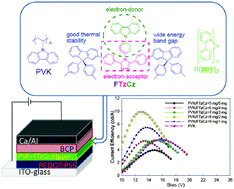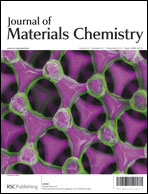Bipolar material with spiro-fluorenyl terminals: synthesis, characterization and application for enhancement of electrophosphorescence†
Abstract
We have designed a novel bipolar material (FTzCz) consisting of spiro-fluorenyl terminals and a bipolar core to enhance emission efficiency of phosphorescent light-emitting diodes based on a conventional poly(9-vinylcarbazole) host and Ir(ppy)3 dopant. The core is composed of directly linked hole-transporting carbazolyl and electron-affinitive aromatic 1,2,4-triazolyl groups. The bipolar FTzCz was synthesized by the Suzuki coupling reaction and was well characterized. It exhibited not only good thermal stability due to its rigid and non-planar chemical structure, but also facilitated hole- and electron-affinities simultaneously. Blending the bipolar FTzCz with PVK significantly enhanced the performance of electrophosphorescent devices [ITO|PEDOT:PSS|(PVK + FTzCz):Ir(ppy)3 (4 wt%)|BCP (10 nm)|Ca (50 nm)|Al (100 nm)]. The maximum luminance and maximum luminance efficiency were enhanced from 3550 cd m−2 and 5.6 cd A−1 (neat PVK-based device) to 4510 cd m−2 and 9.9 cd A−1 (blend device with PVK : FTzCz = 8 : 2), respectively. Our results demonstrate the efficacy of the bipolar FTzCz in enhancing performance of electrophosphorescent devices.


 Please wait while we load your content...
Please wait while we load your content...